| Listing 1 - 10 of 22 | << page >> |
Sort by
|
Article
Abstract | Keywords | Export | Availability | Bookmark
 Loading...
Loading...Choose an application
- Reference Manager
- EndNote
- RefWorks (Direct export to RefWorks)
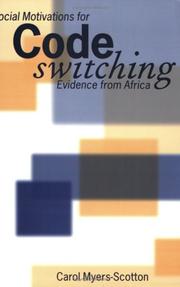
ISBN: 0198239238 Year: 1995 Publisher: Oxford [etc.] : Oxford University Press,
Abstract | Keywords | Export | Availability | Bookmark
 Loading...
Loading...Choose an application
- Reference Manager
- EndNote
- RefWorks (Direct export to RefWorks)
Codeswitching may be broadly defined as the use of two or more linguistic varieties in the same conversation. Using data from multilingual African context, Carol Myers-Scotton advances a theoretical argument which aims at a general explanation of the motivations underlying the phenomenon. She treats codeswitching as a type of skilled performance, not as the 'alternative strategy' of a person who cannot carry on a conversation in the language in which it began. Speakers exploit the socio=psychological values associated with different linguistic varieties in a particular speech community: by switching codes speakers negotiate a change in social distance between themselves and other participants in a conversation. Switching between languages has much in common with making stylistic choices within the same language: it is as if bilingual and multilingual speakers have an additional style at their command when they engage in codeswitching.
CHANGEMENT DE CODE (LINGUISTIQUE) --- SOCIOLINGUISTIQUE --- MARQUE (LINGUISTIQUE) --- AFRIQUE --- AFRIQUE --- CHANGEMENT DE CODE (LINGUISTIQUE) --- SOCIOLINGUISTIQUE --- MARQUE (LINGUISTIQUE) --- AFRIQUE --- AFRIQUE
Book
ISBN: 2130463541 9782130463542 Year: 1994 Volume: 109 30,2 Publisher: Paris PUF
Abstract | Keywords | Export | Availability | Bookmark
 Loading...
Loading...Choose an application
- Reference Manager
- EndNote
- RefWorks (Direct export to RefWorks)
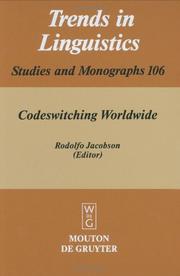

ISBN: 3110151510 3110812193 9783110812190 9783110151510 Year: 2011 Volume: 106 Publisher: Berlin Boston
Abstract | Keywords | Export | Availability | Bookmark
 Loading...
Loading...Choose an application
- Reference Manager
- EndNote
- RefWorks (Direct export to RefWorks)
No detailed description available for "CODESWITCHING WORLDWIDE 1 (JACOBSON) TILSM 106 E-BOOK".
Code switching (Linguistics) --- Bilingualism --- Changement de code (Linguistique) --- Bilinguisme --- Language shift --- Switching (Linguistics) --- Linguistics --- Diglossia (Linguistics) --- Script switching (Linguistics)
Multi
ISBN: 9517650809 Year: 2001 Publisher: Abo : Åbo akademis förlag = Åbo akademi university press,
Abstract | Keywords | Export | Availability | Bookmark
 Loading...
Loading...Choose an application
- Reference Manager
- EndNote
- RefWorks (Direct export to RefWorks)
Theses --- Bilingualism --- Code switching (Linguistics) --- Finnish language --- Hungarian language --- Code switching (Linguistics). --- CHANGEMENT DE CODE (LINGUISTIQUE) --- FINNOIS (LANGUE) --- HONGROIS (LANGUE) --- BILINGUISME --- AUSTRALIE
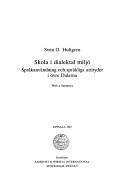
ISBN: 9155414850 9789155414856 Year: 1983 Volume: vol 18 Publisher: Uppsala : Almqvist & Wiksell : Acta universitatis upsaliensis,
Abstract | Keywords | Export | Availability | Bookmark
 Loading...
Loading...Choose an application
- Reference Manager
- EndNote
- RefWorks (Direct export to RefWorks)
Swedish language --- -Diglossia (Linguistics) --- -Language and education --- -Swedish language --- -Ruotsi language --- Svenska language --- Scandinavian languages --- Educational linguistics --- Education --- Language and languages --- Language shift --- Linguistics --- Sociolinguistics --- Code switching (Linguistics) --- Dialects --- -Social aspects --- Diglossia (Linguistics) --- Language and education --- Taalgebruik. --- Standaardtaal. --- Dialecten. --- Zweeds. --- Diglossie --- Suédois (langue) --- Changement de code (linguistique) --- Social aspects --- Étude et enseignement (primaire) --- -Dialects --- Changement de code (linguistique). --- Étude et enseignement (primaire). --- Ruotsi language

ISBN: 9027225419 9786613359322 1283359324 9027279993 9789027279996 9789027225412 9781283359320 6613359327 Year: 1984 Volume: vol 8 Publisher: Amsterdam
Abstract | Keywords | Export | Availability | Bookmark
 Loading...
Loading...Choose an application
- Reference Manager
- EndNote
- RefWorks (Direct export to RefWorks)
Code-switching and related phenomena have met with linguists' increasing interest over the last decade. However, much of the research has been restricted to the structural (grammatical) properties of the use of two languages in conversation; scholars who have tried to capture the interactive meaning of switching have often failed to go beyond more or less anecdotal descriptions of individual, particularly striking, cases. The book bridges this gap by providing a coherent, comprehensive and generative model for language alternation, drawing on recent trends and methods in conversational analysis. The empirical basis is the speech of Italian migrant children in Constance, Germany.
Pragmatics --- Conversatie. --- Codewisseling [Taalwetenschap]. --- Bilinguisme --- Conversation. --- Codes (Passage de) [Linguistique]. --- Tweetaligheid. --- Code switching (Linguistics) --- Talking --- Colloquial language --- Etiquette --- Oral communication --- Language shift --- Switching (Linguistics) --- Bilingualism --- Linguistics --- Diglossia (Linguistics) --- Script switching (Linguistics) --- Changement de code (linguistique) --- Linguistique --- Conversation
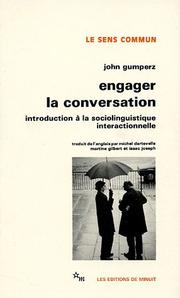
ISBN: 270731286X 9782707312860 Year: 1989 Publisher: Paris : Editions de Minuit,
Abstract | Keywords | Export | Availability | Bookmark
 Loading...
Loading...Choose an application
- Reference Manager
- EndNote
- RefWorks (Direct export to RefWorks)
Sociolinguistics --- Bilingualism in children --- Interpersonal communication --- Conversation --- Sociolinguistique --- Bilinguisme chez l'enfant --- Communication interpersonnelle --- Bilinguisme --- --Sociolinguistique --- --Communication and culture --- Bilingualism --- Sociolinguistics. --- Communication and culture --- SOCIOLINGUISTIQUE --- STATUT SOCIAL --- CHANGEMENT DE CODE LINGUISTIQUE --- LANGAGE
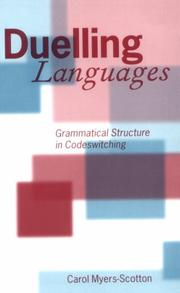
ISBN: 019823712X Year: 1993 Publisher: Oxford : Clarendon Press,
Abstract | Keywords | Export | Availability | Bookmark
 Loading...
Loading...Choose an application
- Reference Manager
- EndNote
- RefWorks (Direct export to RefWorks)
The goal of this book is to describe and explain intrasentential codeswitching - the production of two or more languages within the same sentence. Most linquists who do not study codeswitching think of it as belonging strictly in the domain of sociolinguistics. Most codeswitching studies do indeed have a social aspect, because they typically use naturally occurring performance data as their base. However, this book is just as much a study in grammatical theory as a study of language in use. The specific research question addressed is this: when speakers alternate between two or more linguistic varieties, how free is this alternation from the structural point of view? Carol Myers-Scotton develops a model of the morphosyntactic constraints on codeswitching; she concludes that the principles governing codeswitching are the same everywhere. Her findings support a lexically based model of language production.
Book
ISBN: 2738491480 Year: 2000 Publisher: Paris : Harmattan,
Abstract | Keywords | Export | Availability | Bookmark
 Loading...
Loading...Choose an application
- Reference Manager
- EndNote
- RefWorks (Direct export to RefWorks)
Serer language --- Multilingualism --- Code switching (Linguistics) --- Serer (Langue) --- Multilinguisme --- Changement de code (Linguistique) --- Usage --- Social aspects --- Aspect social --- Senegal --- Sénégal --- Languages --- Political aspects. --- Langues --- Aspect politique --- Sénégal
| Listing 1 - 10 of 22 | << page >> |
Sort by
|

 Search
Search Feedback
Feedback About UniCat
About UniCat  Help
Help News
News